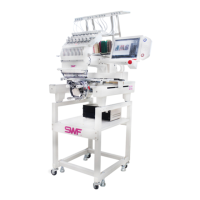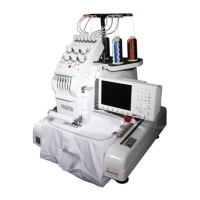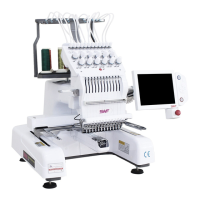DISTINCTIVE FEATURES Page: 10 Zoom-in;Zoom-out Explains the magnification and reduction capabilities of embroidery designs by percentage.
Automatic Offset Explains automatic frame return to offset point after completion for easy frame replacement.
Manual Offset Describes manual frame return to pre-set position for easier application and replacement.
Return to Origin Allows returning the embroidery frame to the starting position during operation.
Automatic Trimmer Explains automatic operation of the trimmer based on design code and settings.
Edit Function Allows deletion, change, or insertion of stitch data and functional codes.
Display of RPM Displays the revolutions per minute of the machine's operation.
Position Marker Utilizes a laser beam to check frame and hoop locations during design tracing.
CAUSES OF TROUBLE AND TROUBLESHOOTING Page: 57 Wrong Stop Position Troubleshooting for problems related to loose belts or encoder issues causing incorrect stopping.
Defective Jump Troubleshooting for faulty SMPS, jump motor, connectors, or switches causing jump defects.
Twisted Embroidery Solutions for twisted embroidery caused by bad tape, belt tension, or rail obstruction.
Thread Break Troubleshooting for thread breaks due to stitch density, needle size, damage, or placement.
Needle Break Troubleshooting for needle breaks due to damage, incorrect type, contact issues, or placement.
Embroidery Contraction Solutions for embroidery contraction caused by thread tension, presser foot pressure, or needle issues.
Poor Trimmer Operation Troubleshooting for trimmer circuit fuses, motor connection, connectors, and indicator lamps.
Trimming Failure Problems with blades not operating, loose tension, damage, or wrong return position.
DISTINCTIVE FEATURES Page: 10 Zoom-in;Zoom-out Explains the magnification and reduction capabilities of embroidery designs by percentage.
Automatic Offset Explains automatic frame return to offset point after completion for easy frame replacement.
Manual Offset Describes manual frame return to pre-set position for easier application and replacement.
Return to Origin Allows returning the embroidery frame to the starting position during operation.
Automatic Trimmer Explains automatic operation of the trimmer based on design code and settings.
Edit Function Allows deletion, change, or insertion of stitch data and functional codes.
Display of RPM Displays the revolutions per minute of the machine's operation.
Position Marker Utilizes a laser beam to check frame and hoop locations during design tracing.
CAUSES OF TROUBLE AND TROUBLESHOOTING Page: 57 Wrong Stop Position Troubleshooting for problems related to loose belts or encoder issues causing incorrect stopping.
Defective Jump Troubleshooting for faulty SMPS, jump motor, connectors, or switches causing jump defects.
Twisted Embroidery Solutions for twisted embroidery caused by bad tape, belt tension, or rail obstruction.
Thread Break Troubleshooting for thread breaks due to stitch density, needle size, damage, or placement.
Needle Break Troubleshooting for needle breaks due to damage, incorrect type, contact issues, or placement.
Embroidery Contraction Solutions for embroidery contraction caused by thread tension, presser foot pressure, or needle issues.
Poor Trimmer Operation Troubleshooting for trimmer circuit fuses, motor connection, connectors, and indicator lamps.
Trimming Failure Problems with blades not operating, loose tension, damage, or wrong return position.



